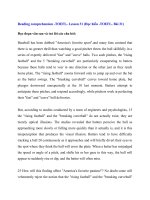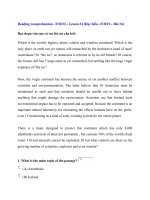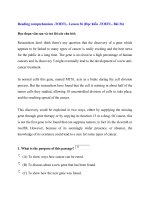Đọc hiểu -TOEFL- Bài 12 pdf
Bạn đang xem bản rút gọn của tài liệu. Xem và tải ngay bản đầy đủ của tài liệu tại đây (94.2 KB, 8 trang )
Reading comprehension -TOEFL- Lesson 12 (Đọc hiểu -TOEFL- Bài 12)
Đọc đoạn văn sau và trả lời các câu hỏi:
Carnegie Hall, the famous concert hall in New York City, has again undergone a
restoration. While this is not the first, it is certainly the most extensive in the
building's history. As a result of this new restoration, Carnegie Hall once again has
the quality of sound 5 that it had when it was first built.
Carnegie Hall owes its existence to Andrew Carnegie, the wealthy owner of a steel
company in the late 1800s. The hall was finished in 1891 and quickly gained a
reputation as an excellent performing arts hall 10 where accomplished musicians
gained fame. Despite its reputation, however, the concert hall suffered from several
detrimental renovations over the years. During the Great Depression, when fewer
people could afford to attend performances, the directors sold part of the building
to commercial businesses. As a result, a coffee shop was opened 15 in one corner
of the building, for which the builders replaced the brick and terra cotta walls with
windowpanes. A renovation in 1946 seriously damaged the acoustical quality of
the hall when the makers of the film Carnegie Hall cut a gaping hole in the dome
of the ceiling to allow for lights and air vents. The hole was later 20 covered with
short curtains and a fake ceiling, but the hall never sounded the same afterwards.
In 1960, the violinist Isaac Stern became involved in restoring the hall after a
group of real estate developers unveiled plans to demolish 25 Carnegie Hall and
build a high-rise office building on the site. This threat spurred Stern to rally public
support for Carnegie Hall and encourage the City of New York to buy the property.
The movement was successful, and the concert hall is now owned by the city. In
the current restoration, builders tested each new material for its 30 sound qualities,
and they replaced the hole in the ceiling with a dome. The builders also restored
the outer walls to their original appearance and closed the coffee shop. Carnegie
has never sounded better, and its prospects for the future have never looked more
promising.
1. This passage is mainly about
(A) changes to Carnegie Hall
(B) the appearance of Carnegie Hall
(C) Carnegie Hall's history during the Great Depression
(D) damage to the ceiling in Carnegie Hall
2. The word "extensive" in line 3 could be best replaced by which of the
following?
(A) fabulous
A
B
(B) thorough
(C) devoted
(D) continuous
3. In line 11, what is the meaning of the word "detrimental"?
(A) dangerous
(B) significant
(C) extreme
(D) harmful
4. What major change happened to the hall in 1946?
(A) The acoustic dome was damaged.
D
A
(B) Space in the building was sold to commer-cial businesses.
(C) The walls were damaged in an earthquake.
(D) The stage was renovated.
5. Who was Andrew Carnegie?
(A) a violinist
(B) an architect
(C) a steel mill owner
(D) mayor of New York City
6. Which of the following words could best replace the word "gaping" in line
18?
(A) small
C
D
(B) round
(C) vital
(D) wide
7. The word "fake" in line 20 is most similar to which of the following?
(A) low
(B) false
(C) thin
(D) handsome
8. What was Isaac Stern's relationship to Carnegie Hall?
(A) He made the movie "Carnegie Hall" in 1946.
B
C
(B) He performed on opening night in 1891.
(C) He tried to save the hall, beginning in 1960.
(D) He opened a coffeeshop in Carnegie Hall during the Depression.
9. What was probably the most important aspect of the recent renovation?
(A) restoring the outer wall
(B) expanding the lobby
(C) restoring the plaster trim
(D) repairing the ceiling
10. Which of the following is closest in meaning to the word "unveiled" in line
24?
(A) announced
D
A
(B) restricted
(C) overshadowed
(D) located
11. The author uses the word "spurred" in line 26 to show that Stern
(A) predicted the result
(B) probed the plans
(C) was told in advance
(D) was stimulated to act
12. How does the author seem to feel about the future of Carnegie Hall?
(A) ambiguous
D
C
(B) guarded
(C) optimistic
(D) negative
13. Which of the following would most likely be the topic of the next
paragraph?
(A) a scientific explanation of acoustics and the nature of sound
(B) a description of people's reactions to the newly renovated hall
(C) a discussion of the coffee shop that once was located in the building
(D) further discussion about the activities of Isaac Stern in 1960
B









